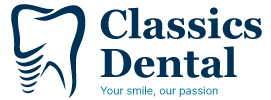Bone Grafting
Dental bone grafting is a procedure where bone graft material to stimulate new bone growth, provide structural support, and create a suitable foundation for dental implants or other dental procedures. Bone grafting is an essential technique in cases where the jawbone has insufficient volume or density due to factors such as tooth loss, trauma, gum disease, or developmental abnormalities.
- Autografts: Autografts involve using bone harvested from the patient’s own body, typically from areas such as the chin & jaw. Autografts are considered the gold standard due to their high success rate and compatibility with the patient’s body.
- Allografts: Allografts use bone graft material obtained from human donors. This material undergoes meticulous processing and sterilization to ensure safety. Allografts provide an abundant supply of bone graft material without the need for additional surgical sites in the patient. They are widely used and have demonstrated successful outcomes in dental bone grafting procedures.
- Xenografts: Xenografts involve using bone graft material derived from animal sources, typically bovine (cow) or porcine (pig) origin. Like allografts, xenografts undergo rigorous processing to remove potential antigens and minimize the risk of immune reactions. Xenografts are a valuable alternative when autografts or allografts are not suitable or available.
- Synthetic grafts: Synthetic grafts are composed of biocompatible materials, such as hydroxyapatite or calcium phosphate. These materials closely resemble natural bone and provide a framework for new bone formation. Synthetic grafts have the advantage of eliminating the need for harvesting bone from the patient or relying on donor sources. They offer predictable outcomes and are often used in conjunction with other graft materials.
During the dental bone grafting procedure, the chosen graft material is placed in the targeted area of the jaw where bone volume or density is deficient. Over time, the graft material provides a scaffold for the patient’s own bone cells to grow and regenerate, eventually integrating with the surrounding bone.
- Autografts: Autografts involve using bone harvested from the patient’s own body, typically from areas such as the chin & jaw. Autografts are considered the gold standard due to their high success rate and compatibility with the patient’s body.
- Allografts: Allografts use bone graft material obtained from human donors. This material undergoes meticulous processing and sterilization to ensure safety. Allografts provide an abundant supply of bone graft material without the need for additional surgical sites in the patient. They are widely used and have demonstrated successful outcomes in dental bone grafting procedures.
- Xenografts: Xenografts involve using bone graft material derived from animal sources, typically bovine (cow) or porcine (pig) origin. Like allografts, xenografts undergo rigorous processing to remove potential antigens and minimize the risk of immune reactions. Xenografts are a valuable alternative when autografts or allografts are not suitable or available.
- Synthetic grafts: Synthetic grafts are composed of biocompatible materials, such as hydroxyapatite or calcium phosphate. These materials closely resemble natural bone and provide a framework for new bone formation. Synthetic grafts have the advantage of eliminating the need for harvesting bone from the patient or relying on donor sources. They offer predictable outcomes and are often used in conjunction with other graft materials.
During the dental bone grafting procedure, the chosen graft material is placed in the targeted area of the jaw where bone volume or density is deficient. Over time, the graft material provides a scaffold for the patient’s own bone cells to grow and regenerate, eventually integrating with the surrounding bone.
For all your dental needs, call 0800 454 535
